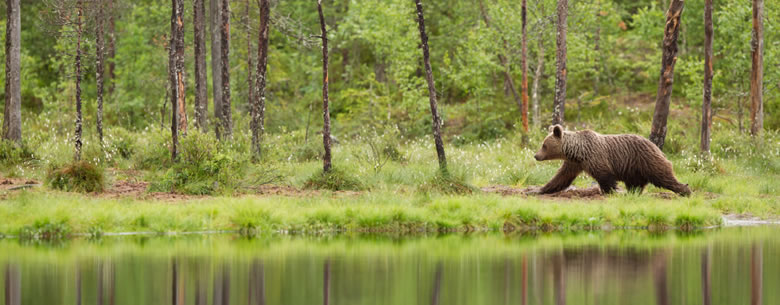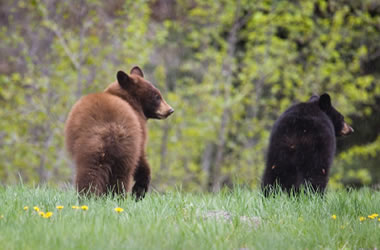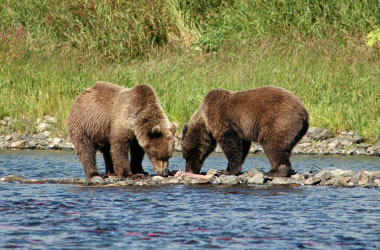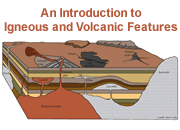
A grizzly bear walking along the edge of a stream. Stream banks are a common place to encounter bears. Image copyright iStockphoto / IndrekV.

North American bear map: This map shows the overlapping geographic ranges of three types of bears that inhabit North America - polar bears, black bears and grizzly bears (also known as brown bears). This map was compiled by superimposing three maps prepared by Karl Musser (American black bear, used under a Creative Commons License), Simon Pierre Barrette (grizzly bear, used under a GNU Free Document License), and Fabio B (polar bear, map in the public domain). Click for an enlarged view.
Introduction
While bear attacks are not a common occurrence, they are becoming more frequent than in the past. Part of the reason for this increase in attacks is due to humans moving into more rural areas where bears live. Another reason for an increase in bear attacks is more people are camping and hiking in bear country.
Knowledge can significantly decrease the probability that you will be attacked by a bear and may help you survive if you are attacked. Important things to know include: the geographic range of bear species; how to identify bears; how to avoid a bear encounter; what to do if you have an encounter; and what to do if you are attacked. Knowing this information and putting it to use can save your life.
Bears and Their Geographic Range
In North America there are three types of bears: black bears, grizzly bears (also known as brown bears in coastal regions of Alaska and Canada) [1] and polar bears. Polar bears are considered the most dangerous to humans, with grizzlies being next in line, followed by black bears. The black bear has the largest geographic range. It can be found across Canada, Alaska, and the western and eastern U.S. with small patches of habitat in the central and south-central U.S. (see map). The grizzly bear can be found in Washington, Montana, Wyoming, Idaho, Alaska, and western Canada. The polar bear, like its name indicates, will only be found in the most northern polar regions of Canada, Alaska, Russia, and all of Greenland.
The geographic ranges of these three types of bears have some overlap. Black bears and grizzly bears can both be found in Montana, Alaska, and western Canada. There are small areas of Alaska and Canada in which all three types of bears can be found.

Black bears: North American black bear cubs. Take note that not all black bears have black fur. Image copyright iStockphoto / birdImages.
Identifying Bears
The white color of polar bears make them easy to identify. However, a little knowledge is required to tell a grizzly bear from a black bear. Being able to tell the difference is important if you are in an area where both types of bear live (see map).
The color of the fur is not always 100% effective for identifying the bear species, as black bears are not always black. They can also have the same dark brown to brown-blonde fur as grizzlies.
On their backs between the front shoulders, grizzly bears usually have a hump of muscle (which black bears do not have). Another distinguishing characteristic is size. A grizzly bear is generally one and a half to two times bigger than a black bear of the same age and gender. [2]
If you are looking at fresh bear tracks, pay attention to the claw marks for determining the species. Black bears have shorter and more curved claws than a grizzly. No matter what species you believe made the tracks, proceed with caution, as you know a bear is possibly in the area.

Grizzly Bears: North American grizzly / brown bears. Grizzly bear fur can range from dark brown, almost black to a light honey brown. Image copyright iStockphoto / brytta.
Avoiding a Bear Encounter
The one and only way to guarantee you will avoid a bear encounter is to stay out of areas where bears live. For many people that just isn't an option because they love hiking, biking, hunting, camping, or just being in nature. If you are a geologist or environmental scientist, your job may require that you go into bear country. So, if you will be where bears live, here are some things that you can do to reduce the possibility of encountering a bear.
When Hiking
Make your presence known while you are hiking. Don't be a stealth hiker. Hike in a group, the more the merrier. Making noise such as talking and singing gives an early warning to bears that they are not alone. [3] This will allow them to walk away from the noise to avoid an encounter.
Be on the lookout for active bear signs such as fresh tracks or fresh bear scat. If possible, avoid feeding areas such as berry patches and stream banks where bears may be feeding or drinking. Hiking in midday will reduce the chance of encountering a bear, as they are less active at that time.
When Camping
Food is the most likely culprit for a bear entering you campsite. The National Parks Conservation Association suggests double-bagging and hanging your food a minimum of 14 feet above the ground and at least 4 feet from the trunk of a tree. [4] If you don't have a place to hang your food, you can put it in sealable plastic containers. If you use containers, it is a good idea to keep them in your car.
Do not place your tent near hanging food or a car where food is stored. The smell may still attract the attention of a bear, and if it does, you want the source of that food smell to be a fair distance from your tent. The suggested distance is 100 yards. [5] If that distance is not possible, make the distance between your tent and your stored food or your eating area as large as possible. Food wrappers, leftovers and dirty dishes can also put the scent of food in the air. Do not keep them near your tent.
You should also place your tent in an area where you will have good visibility. Avoid placing your tent in heavy brush, as you will not be able to see an approaching bear.

Polar Bear: The polar bear is the largest bear species in North America. Image copyright iStockphoto / micheldenijs.
Distant Encounter
If you spot a bear in the distance simply back away, at least a few hundred yards, and find another route. If another route is not available, wait 20 to 30 minutes before heading back down the trail. While going back down the trail, be sure to make noise to announce your presence. This will allow the bear to know that you are coming and not to frighten him into attack mode. It will also give him ample time to move out of your path.
Video: How to use bear spray.
Close Up Encounter
A close encounter is when you encounter a bear close enough to get both the bear's and your own heart beating at a rapid pace. Here is where being able to identify the bear is very useful - because your actions will be different for each type of bear.
During a close encounter with a black bear while you are walking down a trail, you should stop, stand your ground, and assess the situation. If the bear does not instantly come towards you, it is best to slowly back away while keeping an eye on the bear to make sure it isn't following you. If a black bear starts to come towards you, make yourself as big as possible and in a stern voice tell it to go away. If the bear continues to come at you, use your bear spray when he is about 20-30 feet away to deter it from coming any closer. [6]
In the case of a close encounter in your campsite and you know it is a black bear, try to convince it to leave. Once you know the bear has a clear escape path where it won't encounter other humans, stand tall and look at the bear while saying "Get out of here bear" with a stern voice. Keep doing this until the bear leaves. [3] Don't scream at it frantically, as this may scare the bear and cause it to attack. Have bear spray or a strong stick with you in case the bear gets too close. These will be used to deter the bear from an actual attack.
If you have any close encounter with a grizzly bear, remember that they are much more aggressive than black bears and more difficult to discourage. Stand still, keep your eyes on the bear and wait for its reaction. If the grizzly comes too close for comfort, you can try your bear spray to stop it from making contact with you. If it keeps its distance, slowly back away from it while keeping your eyes on the bear. Remember to never turn your back on or run from a bear.
| Sources of Bear Attack Information |
|
[1] Brown Bear: Wikipedia article on brown bears.
[2] Characteristics of Black Bears and Grizzly Bears in Yellowstone National Park: Kerry A. Gunther, Information Paper No. BMO-2, January 2006, for Yellowstone National Park. Hosted on the Internet Archive. [3] Be safe in bear habitat: Article from the Get Bear Smart Society. [4] Avoiding Bear Attack: Article from the National Parks Conservation Association. Hosted on the Internet Archive. [5] Be Bear Aware: Pamphlet by the Center For Wildlife Information. [6] Bear Spray: Safety for People, Safety for Bears: Brochure by BeBearAware.org/Center For Wildlife Information, 2009, published on the Wild Aware Utah website. [7] Understanding the Bear's Mindset: Article published by the National Park Service. Hosted on the Internet Archive. [8] Surviving a bear encounter: Pamphlet from Montana Fish, Wildlife and Parks. Hosted on the Internet Archive. |
Attack: Physical Contact
The National Park Service breaks bear attacks into two groups: 1) defensive attacks and 2) predatory attacks. Learning how to recognize what type of attack is happening will allow you to appropriately respond to the attack. [7] Never run from a bear in attack mode, as they are much faster than you. Also, they see your flight response as a fleeing animal and will chase you.
Most bear attacks are defensive attacks. They are called defensive attacks because the bear is generally caught off guard by a human presence. With that surprise comes their instinct to defend themselves, their cubs, or their food. Predatory bear attacks are rare for grizzly bears and black bears. Polar bears, on the other hand, have been known to track and attack humans.
Protecting Yourself in a Defensive Attack
Defensive attacks are the most common type of bear attack. There are a few things to look for when a bear attack will be a defensive attack. Common bear actions in these types of attacks include: hop charges, a fake rush towards you, slapping at the ground, teeth clacking and huffs. This is the bear's way of saying, "I don't know what you are or what you're doing here, but you are not welcome." Sometimes a bear will stand on its hind legs to get a better look at you and better smell to determine if you are a threat to them. If the bear does not attack after these motions, slowly back away while facing the bear. Do not turn your back on or run from a frightened bear. [7]
If the bear makes physical contact with you in a defensive attack, it is best to play dead in an attempt to defuse the situation. While on the ground either lay flat on your stomach with your fingers interlocked over your neck and spread your elbows and legs so it is harder for the bear to roll you over; or, curl up in the fetal position, again with your fingers interlocked over your neck. [3]
In a defensive attack, a bear does not intend to eat you - it is just trying to eliminate the threat. Generally, once the bear believes that you, the threat, have been eliminated, it will leave. Continue lying on the ground for at least 20-30 minutes to make sure the bear is not lurking around watching. If the attack continues and you feel he will never leave, fight back with any weapon possible. Use bear spray if you haven't already used it all trying to deter it from the attack. Usually rocks and sticks are the only weapons available, so make sure to aim for the face. Concentrate on sensitive spots like the nose and eyes.
Protecting Yourself During a Predatory Attack
In a predatory attack the bear intends to have you for dinner. Do whatever is necessary not to become his next meal. If you have a gun, use it. If you have bear spray, use it. If you have only sticks and stones, aim for the most sensitive areas. These areas would be on the face, focusing mostly on the nose and eyes. In a predatory attack it is a matter of life and death, so do everything possible to save your life.
Protect Yourself with Knowledge
Knowing what to do to avoid a bear encounter and what to do if you become face-to-face with a bear is the best way to be safe. We have links to more information about bears in the reference box on this page.
| More General Geology |
 |
Fossils |
 |
Igneous and Volcanic Features |
 |
Geology Dictionary |
 |
Diamonds |
 |
Minerals |
 |
Divisions of Geologic Time |
 |
Land Below Sea Level |
 |
Gifts That Rock |

Find Other Topics on Geology.com:

|

| ||

|

| ||

|

| ||

|

|
